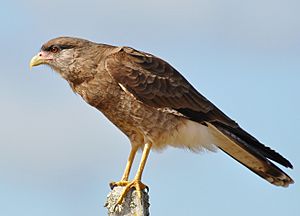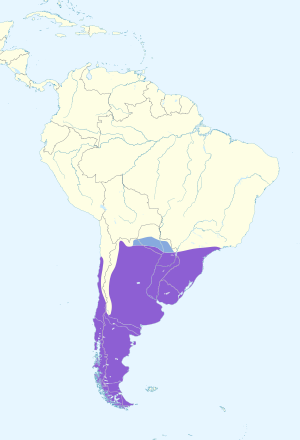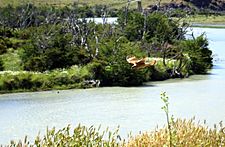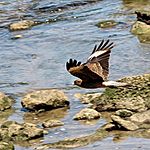Chimango caracara facts for kids
Quick facts for kids Chimango caracara |
|
|---|---|
 |
|
| A chimango caracara in Rio Grande do Sul, Brazil | |
| Conservation status | |
| Scientific classification | |
| Genus: |
Milvago
|
| Species: |
chimango
|
 |
|
| Synonyms | |
|
|
The chimango caracara (Milvago chimango) is a type of bird of prey. It belongs to the Falconidae family, which includes falcons and other caracaras. You can find this bird in several South American countries. These include Argentina, Bolivia, Brazil, Chile, Paraguay, and Uruguay. Sometimes, it even visits the Falkland Islands.
Contents
About the Chimango Caracara
What's in a Name?
Scientists group birds into different families. The chimango caracara is part of the Milvago group. It is closely related to falcons. There are two main types, or subspecies, of the chimango caracara. These are M. c. chimango and M. c. temucoensis.
What Does It Look Like?
The chimango caracara is about 32 to 43 centimeters (13 to 17 inches) long. It weighs between 170 and 260 grams (6 to 9 ounces). Its wings can spread up to 80 to 99 centimeters (31 to 39 inches) wide.
Both male and female birds look similar. They are mostly brownish all over. They have dark streaks on their heads and necks. Their bellies might look mottled or barred with reddish-brown. Their tail feathers are grayish and white. They also have a wide black band near the end of their tail.
Male birds have yellow skin around their eyes. Their legs and feet are also yellow. Females have reddish-pink skin around their eyes. Their legs and feet are bluish-gray. Young birds have a strong reddish color. They have bare parts like the adult female. The M. c. temucoensis subspecies is a darker smoky brown. Its underparts have more markings.
Where Does It Live?
The chimango caracara lives in many parts of South America. The M. c. chimango subspecies is found in northern and central Chile. It also lives from central Argentina east through Paraguay, southern Brazil, and Uruguay. It sometimes visits Bolivia.
The M. c. temucoensis subspecies lives in southern Chile and southern Argentina. This includes Tierra del Fuego all the way to Cape Horn. Some birds have even flown to the Falkland Islands. In the early 1900s, this bird was also brought to Easter Island.
This bird likes many open areas. You can find it in grassy foothills, heathland, and shrub–steppe. It also lives in marshes, open woods, and even towns. It is very common in the ranching areas of the Argentinian Pampas. It is also often seen near fishing villages. It is the most common bird of prey in Argentinean Patagonia. It usually lives below 2,000 meters (6,600 feet). But it can be found as high as 4,000 meters (13,000 feet).
Chimango Caracara Behavior
How It Moves Around
Most chimango caracaras stay in the same area all year. However, birds in the far south sometimes move north. This usually happens during the southern winter. Some northern birds also travel to Bolivia. A few have even been seen in the Falkland Islands.
What It Eats
The chimango caracara eats many different things. It is a small hunter and also eats leftovers. It hunts insects, lizards, and frogs. It also eats the eggs and young of other birds. Small rodents are also part of its diet. It often eats small animals killed on roads. It also scavenges from larger animal carcasses. Sometimes, it eats rotten apples or fungi. It even finds food in animal dung.
This bird usually hunts while flying. It flies about 10 meters (33 feet) above the ground. Then it drops down to catch its food. It often follows farmers when they are plowing fields. More than 100 birds have been seen together doing this. They also gather at grass fires. They visit fishing villages to eat waste. They sometimes steal food from other birds of prey. They have even been seen catching live fish from the water.
How It Raises Its Young
The chimango caracara breeds from September to January. Eggs are usually laid from mid-October to mid-November. It often builds its nest in trees. The nest is a platform made of sticks. It can be up to 30 meters (98 feet) high. In areas with few trees, it might nest on the ground. It can also build nests on tussocks in a marsh.
Usually, two or three eggs are laid. Sometimes, there can be up to five eggs. The eggs hatch in 26 to 32 days. The young birds can fly about 32 to 41 days after hatching. Both parents help build the nest. They also take turns sitting on the eggs. Both parents feed the young birds.
Smart Birds
The chimango caracara is a very smart bird. It is good at solving problems. It likes to explore new things. It is not easily scared by new objects. This helps it find new food sources. These traits help it be successful in many different places.
What It Sounds Like
The chimango caracara is usually loudest during breeding season. This is especially true if people are near its nest. It also calls when fighting over food. Its most common call is a loud, squealing "keeeeee-eh". It often makes this sound while flying. It also makes a chattering "keag-keah-keah..." or "ke-ew, ke-ew, ke-ew". It can make other squeals, growls, and hissing sounds too.
Status and Safety
The IUCN says the chimango caracara is of "Least Concern." This means it is not currently at risk of disappearing. It lives in a very large area. Its population size is not fully known. However, it is believed to be growing. No immediate threats have been found. It is doing well, possibly because of deforestation. It is the most common bird of prey in much of Chile and Argentina.
Gallery
-
In Torres del Paine National Park, Chile
-
Likely the southern subspecies M. c. temucoensis, near Concepcion, Chile
See also
 In Spanish: Chimango para niños
In Spanish: Chimango para niños





